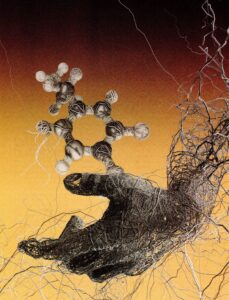One of my favorite quotes about art is by Alberto Giocometti, a 20th century Swiss sculptor and painter. He said, “The object of art is not to reproduce reality, but to create a reality of the same intensity.”
One intense endeavor is the search for new knowledge. I never thought much about what kind of art would portray this search, but it “plopped in my lap”, as the old saying goes. Three drawings now hang on a wall outside my office that capture the intensity of the quest for new knowledge.
The art came from the A&M Foundation, that raises major donations and estate gifts for Texas A&M University. The drawings appeared in a feature story about the Hagler Institute for Advanced Study in the Foundation’s magazine, Spirit.
I have loved these pieces of art since I first saw them, and I want to share them with you in this post. They are best seen on a computer monitor.
A little background is helpful. I am Associate Director of the Hagler Institute. The Institute brings world-class researchers, called Fellows, to Texas A&M for from three to twelve months to collaborate with our faculty and students. These relationships foster an enrichment of ideas and solutions to tough problems. Texas A&M is good place for these Fellows to work, as it is the largest research institution in Texas at $1.153 billion dollars in research funds (2022 data).
Briefly, here is the way the institute works. The institute gives each college at Texas A&M the same basic allotment of nominations. Any member of A&M’s faculty can nominate a scholar located anywhere in the world with whom they would like to collaborate. On a two-page form the nominator describes the nominees’ accomplishments and explains the importance of having that person at Texas A&M. Because there are resource implications, the college deans forward the nominations to the institute and agree to our policies.
The nominations, which are secret, go to a revolving committee of nine University Distinguished Professors, who evaluate the nominees over several months to ensure they meet the high standards of the institute. If you are a scientist, for example, you must be in the National Academy of Sciences to be considered. The nominee must also demonstrate an ability to work with others and be currently productive. These high standards enhance the prestige of being chosen for the Hagler Institute.
The institute’s staff helps recruit the approved nominees. Once a Fellow is recruited, the institute pays 70% of his or her compensation. It also provides two fellowships to Ph.D. students (per Fellow), allowing students to work with Fellows and their hosts. The nominating college pays the remaining 30% of the compensation, as well as the cost of travel and housing.
I joined the institute after its first year of operation, and I have worked there for ten years. During that time, we have brought to A&M more than 100 of the world’s finest scholars, in everything from Shakespeare studies to quantum theory. We attract a new group of Fellows each year. Although the institute was not designed as a recruiting arm for A&M, 23% of Fellows have joined A&M’s faculty after completing their time in the institute.
The institute has brought in several Nobel Prize winners, a three-time recipient of the State Prize of Russia, awardees of the National Medal of Science, the National Humanities Medal, many recipients of prestigious research honors, and members of U.S. national academies and exclusive academies around the world.
With that background I invite you to now enjoy three pieces of art used by the A&M Foundation for their 2017 “Great Minds” Spirit article about the Hagler Institute for Advanced Study.



Aren’t these just “too cool?”
Leave a Reply